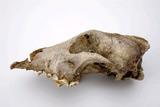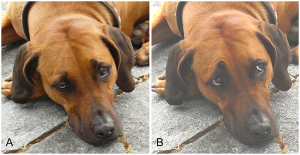
A 33,000 year old proto-dog skull from Beligum
Wolves were one of the first animals to be domesticated, with genetic data indicating it may have occurred as early as 33,000 years ago. That’s over 20,000 years earlier than the domestication of wheat, sheep, cows and all the other classic creatures. This super-early domestication was believed to have been made possible by the fact wolves effectively domesticated themselves. Humans, being inherently messy animals, provided a great source waste and scraps for an animal to live off. The tamer and less aggressive an animal was, the more likely their scrounging was to be tolerated around the campsite. Thus evolution pushed them in that direction until we got the delightful, less bitey dog who we’re happy to feed scraps to.
But some researchers wondered whether evolution was being a bit more cynical than that. Dogs are highly paedomorphic, meaning that they retain child-like traits well into adulthood. Their face (and facial expression) in particular are more similar to wolf pups than to adult wolves. The researchers wondered whether this might be the result of an evolutionary push to make early dogs more appealing to hunter-gatherers, playing on their heart-strings by tapping into our love for big eyes and cute faces.
So these scientists went to an animal shelter and quantified how paedomorphic the facial expressions of various dogs were. They then looked to see which dogs were adopted by the easily manipulated humans. And sure enough, they found a fairly strong correlation between one paedomorphic trait in particular and a dogs’ chances of being adopted. The more likely the dog was to raise their inner eyebrows when being observed by potential owners, the more likely those humans were to become actual owners.

A dog being normal, then raising up the inner eyebrow.
Several other puppy-like traits were linked to chance of adoption, and some were actually negatively correlated. Perhaps most surprisingly, the more a dog wagged its tail the less likely it was to be adopted! But none of these had an effect as significant as the inner eyebrow raising. So if you ever find yourself reincarnated as a dog and want to please humans, start doing that.
Based on all this the researchers concluded that the domestication of dogs was not just about them loosing aggression so they would be tolerated by humans; but actively becoming appealing to hunter-gatherers through paedomorphic characteristics. This is the first piece of evidence that suggests this (although you could’ve probably guessed it may have been involved). Of course, there may be other factors at work. The researchers point out that the movements of the inner eyebrow are often associated with sadness, and that might be what the adopters were picking up on rather than an inherent preference for paedomorphism. And there’s the obvious one: this study wasn’t conducted on hunter-gatherers deciding if they should let a wolf hang around their camp because it looks cute.
Still, this study is dealing with real actions: people adopting dogs. It’s all to easy to say “I like this” on a survey and for researchers to extrapolate out some grand evolutionary conclusions for all this. The fact people are willing to invest time and effort in animals based on these characteristics suggests that there is a real effect there, although I doubt we’ll ever know for sure just how strong a role it played in the domestication of dogs. But then, that’s science for you: a finicky, uncertain mistress. Kinda like my girlfriend.
As an aside, one of the researchers involved in the study works from Mars; the company that owns Pedigree. So if you start seeing dogfood commercials involving a lot of eyebrow raising, this is why. They’re trying to replicate the evolutionary success of the domestic dog.
References
Thalmann O, Shapiro B, Cui P, Schuenemann VJ, Sawyer SK, Greenfield DL, Germonpré MB, Sablin MV, López-Giráldez F, Domingo-Roura X et al. . 2013. Complete mitochondrial genomes of ancient canids suggest a European origin of domestic dogs. Science 342(6160):871-874.
Waller BM, Peirce K, Caeiro CC, Scheider L, Burrows AM, et al. (2013) Paedomorphic Facial Expressions Give Dogs a Selective Advantage. PLoS ONE 8(12): e82686. doi:10.1371/journal.pone.0082686

